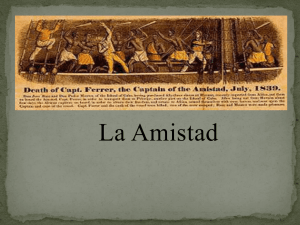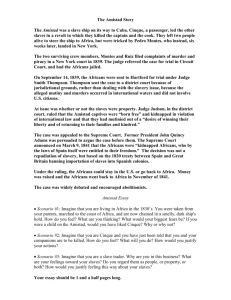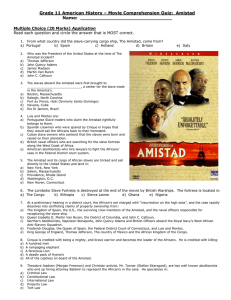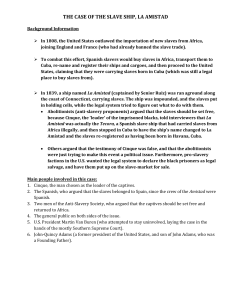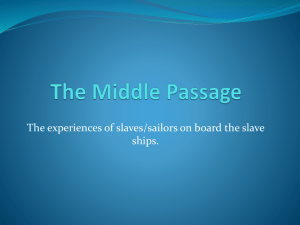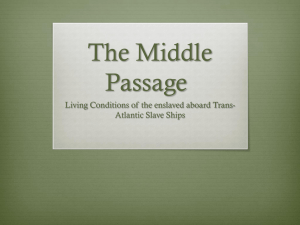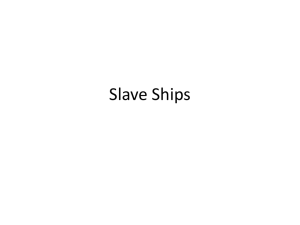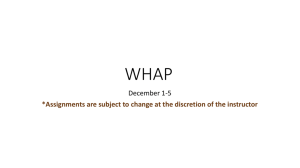Amistad 2014
advertisement
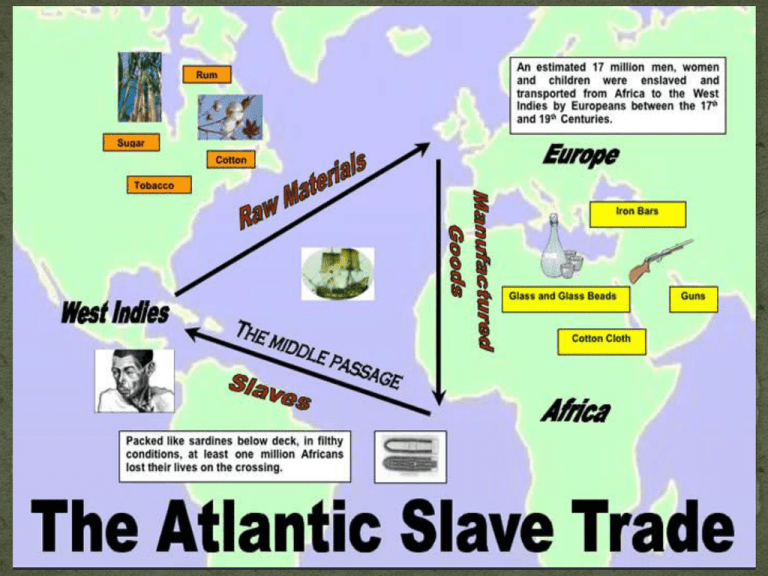
1789 – The U.S. Constitution ratified with clause equating slaves to 3/5ths of a white citizen and provision that international slave trade would end within 20 years. 1807 – Great Britain abolishes slave trade. 1819 – A U.S. law equates slave trading with piracy, punishable by death. 1820 – The Missouri Compromise: Missouri is admitted as a slave state, balanced by the admission of Maine as a free state, also includes an agreement to bar slavery from northern federal territories. President James Monroe orders first U.S. Navy patrol against slave ships on West African coast. 1836 – In response to petitions calling on Congress to abolish slavery in the District of Columbia, the House of Representatives implements the “gag rule,” automatically tabling abolitionist petitions. The policy is repeatedly renewed over the coming years. 1839 – January… Sengbe Pieh (Cinque), a Mende, is seized in West Africa and sold into slavery. - April… The Portuguese slaving brig Tecora loads slaves off Lomboko, at the mouth of the Gallinas River, on the West African coast below the British Colony of Sierra Leone. - Late June…The Africans are brought to Havana, Cuba. Jose Ruiz, a Spanish planter from Puerto Principe, buys 49 adult males, paying $450 for each. Pedro Montes, another planter from the same region, buys four children, three of them girls. June 28 1839 – Ruiz and Montes walk their 53 slaves through Havana, board the Amistad at 8:00pm and by midnight get underway. July 1st – Cinque and Grabeau free and arm themselves and then the others. July 2nd – Revolt Over the next two months the Amistad sails east by day, north by night, through the Bahamas and up the North American coast, into United States waters. August 25th - The Amistad anchors off Long Island and lands a shore party to obtain provisions. Late in the afternoon, Henry Green and company encounter the Africans’ shore party. August 26th - Early morning, Lt. Richard W. Meade, commanding the surveying brig USS Washington, seizes the schooner and escorts it to New London. They claim a salvage award for their actions. La Amistad Spanish for “Friendship” the Amistad was the slave ship being transported from Havana to Puerto Principe, Cuba. It was captured off the coast of Long Island by the USS Washington of the United States Revenue Cutter Service. The US Revenue Cutter Service is the forerunner to what is now the Coast Guard. The initial ruling by the circuit court stated that the alleged mutiny was conducted on a Spanish ship in international waters, therefore the court had no jurisdiction and could not rule. The defense attorneys of the African slaves appealed and the US Supreme Court chose to hear the case. The US Supreme Court heard the case in February 1841. The case was heard over a period of a week and an eloquent closing argument was written by John Q. Adams. The US Navy. An obscure law permitted them to stake a claim to a ship, cargo, or property of any ship operating illegally and seized in our waters. 2. Queen Isabella of Spain. She is demanding for the ship to be returned with its contents as it is Spanish property. 3. Jose Ruiz and Pedro Montes, Portuguese merchants who fraudulently claim the slaves were born in Cuba and bought legally and therefore should be returned to them. 4. Cinque and the slaves, who were illegally brought to the America’s and should be freed to go back to Sierra Leone. 1. Because the case was thrown out by the lower court the Supreme Court would have to decide one of 4 options. 1. Were the slaves considered salvage? (Due to a maritime law back then, the cargo of a seized ship could become the property of the Naval officers who had taken custody of that ship.) 2. Were they the property of Spain as Queen Isabella II of Spain claimed? 3. Or were they the property of the Cubans who bought them? 4. Or finally, because of the circumstances of their capture and transportation, they should be set free? YOUR ASSIGNMENT You will assume the role of a Supreme Court Justice. You will decide which of the previous 4 options you would decide as a verdict. (You must know all 4 options.) Your decision is based on what you have noted and the closing argument from the Hollywood movie version of Amistad. It is important to understand John Quincy Adams was a former president who wrote most of the closing argument. As you view this clip, listen to what is being said by Anthony Hopkins portraying John Q. Adams. In particular: 1. His distinct explanation of how our Supreme Court should operate according to the Queen of Spain. 2. His reference to the US Constitution if we accept what Van Buren writes in the Executive Review. 3. What he thinks of Calhoun’s (his former vicepresident) view of slavery being inherent in all society, 4. And finally, his reference to our ancestors / forefathers and their influence in our decision making process. They are the key points made by Adams.
